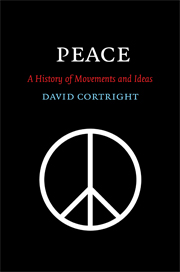Book contents
1 - What is peace?
Published online by Cambridge University Press: 05 June 2012
Summary
Jesus said that peacemakers are to be blessed as children of God, but in the real world they are often dismissed as utopian dreamers or worse, quaking defeatists who live in denial of reality. Jane Addams was one of the most admired persons in the United States in the years before World War I, but when she opposed US entry into the war she was ridiculed and reviled. Those who advocated peace during the 1930s were accused of helping Hitler and aiding appeasement. Disarmament activists during the cold war were sometimes considered dupes of the Soviet Union. Throughout history the cause of peace has been on trial, standing like a forlorn defendant before the court of established opinion, misunderstood and maligned on all sides. Peace is “naked, poor, and mangled,” wrote Shakespeare. To be called a pacifist is almost an insult, to be labeled cowardly or selfish, unwilling to fight for what is right. It is easy to arouse people to war, said Hermann Goering at the Nuremberg trials. “All you have to do is tell them they are being attacked and denounce the pacifists for lack of patriotism …”
This book is a response to the charges against pacifism. It is an attempt to set the record straight by exploring the history of movements and ideas for peace – an opportunity for the cause of peace to have its day in court. This is not an apologia for or paean to pacifism, however – far from it.
- Type
- Chapter
- Information
- PeaceA History of Movements and Ideas, pp. 1 - 22Publisher: Cambridge University PressPrint publication year: 2008

